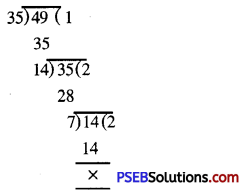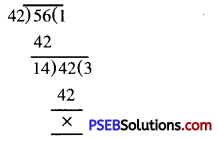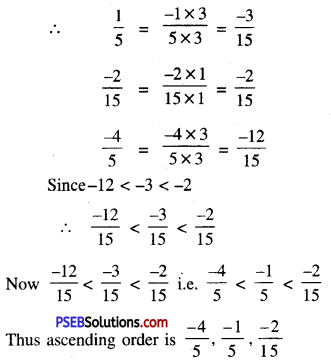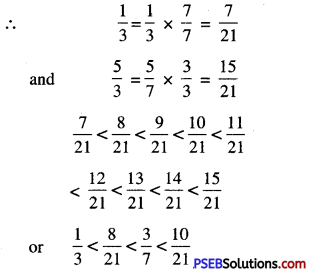Punjab State Board PSEB 7th Class Maths Book Solutions Chapter 9 Rational Numbers Ex 9.1 Textbook Exercise Questions and Answers.
PSEB Solutions for Class 7 Maths Chapter 9 Rational Numbers Ex 9.1
1. Write two equivalent rational numbers of the following :
Question (i).
\(\frac {4}{5}\)
Solution:
\(\frac {4}{5}\) = \(\frac {4}{5}\) × \(\frac {2}{2}\)
= \(\frac {8}{10}\)
\(\frac {4}{5}\) = \(\frac {4}{5}\) × \(\frac {3}{3}\)
= \(\frac {12}{15}\)
∴ Equivalent rational numbers of \(\frac {4}{5}\) are \(\frac {8}{10}\) and \(\frac {12}{15}\)
Question (ii).
\(\frac {-5}{9}\)
Solution:
\(\frac {-5}{9}\) = \(\frac {-5}{9}\) × \(\frac {2}{2}\)
= \(\frac {-10}{18}\)
\(\frac {-5}{9}\) = \(\frac {-5}{9}\) × \(\frac {3}{3}\)
= \(\frac {-15}{27}\)
∴ Equivalent rational numbers of \(\frac {-5}{9}\) are \(\frac {-10}{18}\) and \(\frac {-15}{27}\)
Question (iii).
\(\frac {3}{-11}\)
Solution:
\(\frac {3}{-11}\) = \(\frac {3}{-11}\) × \(\frac {2}{2}\)
= \(\frac {6}{-22}\)
\(\frac {3}{-11}\) = \(\frac {3}{-11}\) × \(\frac {3}{3}\)
= \(\frac {9}{-33}\)
∴ Equivalent rational numbers of \(\frac {3}{-11}\) are \(\frac {6}{-22}\) and \(\frac {9}{-33}\)
![]()
2. Find the standard form of the following rational numbers :
Question (i).
\(\frac {35}{49}\)
Solution:
\(\frac {35}{49}\)
∵ H.C.F. of 35 and 49 is 7

So dividing both the numerator and denominator by 7 we get.
\(\frac {35}{49}\) = \(\frac{35 \div 7}{49 \div 7}\) = \(\frac {5}{7}\)
∴ Standard form of \(\frac {35}{49}\) is \(\frac {5}{7}\)
Question (ii).
\(\frac {-42}{56}\)
Solution:
\(\frac {-42}{56}\)
∵ H.C.F. of -42 and 56 is 14

So dividing both the numerator and denominator by 14 we get.
\(\frac {-42}{56}\) = \(\frac{-42 \div 14}{56 \div 14}\) = \(\frac{-3}{4}\)
∴ Standard form of \(\frac {-42}{56}\) is \(\frac{-3}{4}\)
Question (iii).
\(\frac {19}{-57}\)
Solution:
\(\frac {19}{-57}\)
∵ H.C.F. of 59 and 57 is 19

So dividing both the numerator and denominator by 19 we get.
\(\frac {19}{-57}\) = \(\frac{-19 \div 19}{-57 \div 19}\) = \(\frac{1}{-3}\)
∴ Standard form of \(\frac {19}{-57}\) is \(\frac{1}{-3}\)
![]()
Question (iv).
\(\frac{-12}{-36}\)
Solution:
\(\frac{-12}{-36}\)
∵ H.C.F. of 12 and 36 is 12.

So dividing both the numerator and denominator by 12 we get.
\(\frac{-12}{-36}\) = \(\frac{-12 \div 12}{-36 \div 12}\) = \(\frac{1}{3}\)
Standard form of \(\frac{-12}{-36}\) is \(\frac{1}{3}\)
3. Which of the following pairs represent same rational number ?
Question (i).
\(\frac{-15}{25}\) and \(\frac{18}{-30}\)
Solution:
\(\frac{-15}{25}\) = \(\frac{-15 \div 5}{25 \div 5}\)
= \(\frac{-3}{5}\)
\(\frac{18}{-30}\) = \(\frac{18 \div-6}{-30 \div-6}\)
= \(\frac{-3}{5}\)
∴ \(\frac{-15}{25}\) and \(\frac{18}{-30}\) represents the same number.
Question (ii).
\(\frac{2}{3}\) and \(\frac{-4}{6}\)
Solution:
\(\frac{2}{3}\) = \(\frac{2}{3}\) × \(\frac{1}{1}\)
= \(\frac{2}{3}\)
\(\frac{-4}{6}\) = \(\frac{-4 \div 2}{6 \div 2}\)
= \(\frac{-2}{3}\)
∴ \(\frac{-2}{3}\) and \(\frac{-4}{6}\) doesnot represents the same rational numbers.
Question (iii).
\(\frac{-3}{4}\) and \(\frac{-12}{16}\)
Solution:
\(\frac{-3}{4}\) = \(\frac{-3}{4}\) × \(\frac{4}{4}\)
= \(\frac{-12}{16}\)
\(\frac{-12}{16}\) = \(\frac{-12}{16}\)
∴ \(\frac{-3}{4}\) and \(\frac{-12}{16}\) represents the same rational number.
Question (iv).
\(\frac{-3}{-7}\) and \(\frac{3}{7}\)
Solution:
\(\frac{-3}{4}\) = \(\frac{-3 \div-1}{-7 \div-1}\)
= \(\frac{-3}{4}\)
∴ \(\frac{-3}{-7}\) and \(\frac{3}{7}\) represents the same rational number.
![]()
4. Which is greater in each of the following ?
Question (i).
\(\frac{3}{7}\), \(\frac{4}{5}\)
Solution:
Given rational nrnnbere are \(\frac{3}{7}\) and \(\frac{4}{5}\)
L.C.M. of 7 and 5 is 35
∴ \(\frac{3}{7}\) = \(\frac{3 \times 5}{7 \times 5}\)
= \(\frac{15}{35}\)
and \(\frac{4}{5}\) = \(\frac{4 \times 7}{5 \times 7}\)
= \(\frac{28}{35}\)
∵ Numerator of second is greater than first i.e. 28 > 15
So \(\frac{4}{5}\) > \(\frac{3}{7}\)
Question (ii).
\(\frac{-4}{12}\), \(\frac{-8}{12}\)
Solution:
Given rational numbere are \(\frac{-4}{12}\) and \(\frac{-8}{12}\)
∵ Numerator of first is greater than second i.e. -4 > – 8
∴ \(\frac{-4}{12}\) > \(\frac{-8}{12}\)
Question (iii).
\(\frac{-3}{9}\), \(\frac{4}{-18}\)
Solution:
Given rational numbers are \(\frac{-3}{9}\), \(\frac{4}{-18}\)
\(\frac{-3}{9}\) = \(\frac{-3 \times 2}{9 \times 2}\)
= \(\frac{-6}{18}\)
\(\frac{4}{-18}\) = \(\frac{4 \times-1}{-18 \times-1}\)
\(\frac{-4}{18}\)
Since -4 > – 6.
\(\frac{4}{-18}\) > \(\frac{-3}{9}\)
Question (iv).
-2\(\frac{3}{5}\), -3\(\frac{5}{8}\)
Solution:
-2\(\frac{3}{5}\) = \(\frac{-13}{5} \times \frac{8}{8}\)
= \(\frac{-104}{40}\)
-3\(\frac{5}{8}\) = \(\frac{-29}{8} \times \frac{5}{5}\)
= \(\frac{-135}{40}\)
∵ -104 > -135
∴ \(\frac{-13}{5}\) > \(\frac{-29}{8}\)
Thus, -2\(\frac{3}{5}\) > -3\(\frac{5}{8}\)
![]()
5. Write the following rational numbers in ascending order.
Question (i).
\(\frac{-5}{7}, \frac{-3}{7}, \frac{-1}{7}\)
Solution:
\(\frac{-5}{7}, \frac{-3}{7}, \frac{-1}{7}\)
Here -5 < -3 < -1
i.e. \(\frac{-5}{7}, \frac{-3}{7}, \frac{-1}{7}\)
Therefore, the ascending order is:
\(\frac{-5}{7}, \frac{-3}{7}, \frac{-1}{7}\)
Question (ii).
\(\frac{-1}{5}, \frac{-2}{15}, \frac{-4}{5}\)
Solution:
\(\frac{-1}{5}, \frac{-2}{15}, \frac{-4}{5}\)
L.C.M of 5, 15, 5 is 15

Question (iii).
\(\frac{-3}{8}, \frac{-2}{4}, \frac{-3}{2}\)
Solution:
\(\frac{-3}{8}, \frac{-2}{4}, \frac{-3}{2}\)
L.C.M of 8, 4, 2 is 8
∴ \(\frac{-3}{8}=\frac{-3}{8} \times \frac{1}{1}=\frac{-3}{8}\)
\(\frac{-2}{4}=\frac{-2 \times 2}{4 \times 2}=\frac{-4}{8}\)
\(\frac{-3}{2}=\frac{-3 \times 4}{2 \times 4}=\frac{-12}{8}\)
∴ -12 < -4 < -3
or \(\frac {-12}{8}\) < \(\frac {-4}{8}\) < \(\frac {-3}{8}\)
Hence assending order is \(\frac{-3}{2}, \frac{-2}{4}, \frac{-3}{8}\)
![]()
6. Write five rational numbers between following rational numbers.
Question (i).
-2 and -1
Solution:
Given rational numbers are -2 and -1
Let us write -2 and -1 as rational numbers with 5 + 1 = 6 as denominator.
We have -2 = -2 × \(\frac {6}{6}\)
= \(\frac {-6}{6}\)
\(\frac {-12}{6}\) < \(\frac {-11}{6}\) < \(\frac {-10}{6}\) < \(\frac {-9}{6}\) < \(\frac {-8}{6}\) < \(\frac {-7}{6}\) < \(\frac {-6}{6}\)
Hence five rational numbers between -2 and -1 are :
\(\frac {-11}{6}\),\(\frac {-10}{6}\),\(\frac {-9}{6}\),\(\frac {-8}{6}\),\(\frac {-7}{6}\)
i.e. \(\frac {-11}{6}\),\(\frac {-5}{3}\),\(\frac {-3}{2}\),\(\frac {-4}{3}\),\(\frac {-7}{6}\)
Question (ii).
\(\frac {-4}{5}\) and \(\frac {-2}{3}\)
Solution:
Given rational numbers are \(\frac {-4}{5}\) and \(\frac {-2}{3}\)
First we find equivalent rational numbers having same denominator
Thus \(\frac {-4}{5}\) = \(\frac{-4 \times 9}{5 \times 9}\)
= \(\frac {-36}{45}\)
and \(\frac {-2}{3}\) = \(\frac{-2 \times 15}{3 \times 15}\)
= \(\frac {-30}{45}\)
Now, we choose any five integers -35, -34, -33, -32, -31 between the numerators -36 and -30
Then the five rational numbers between \(\frac {-36}{45}\) and \(\frac {-30}{45}\) are:
\(\frac{-35}{45}, \frac{-34}{45}, \frac{-33}{45}, \frac{-32}{45}, \frac{-31}{45}\)
Hence, five rational numbers between \(\frac {-4}{5}\) and \(\frac {-2}{3}\) are
\(\frac{-35}{45}, \frac{-34}{45}, \frac{-33}{45}, \frac{-32}{45}, \frac{-31}{45}\)
i.e. \(\frac{-7}{9}, \frac{-34}{45}, \frac{-11}{15}, \frac{-32}{45}, \frac{-31}{45}\)
Question (iii).
\(\frac {1}{3}\) and \(\frac {5}{7}\)
Solution:
Given rational numbers are \(\frac {1}{3}\) and \(\frac {5}{7}\)
First we find equivalent rational numbers having same denominator

\(<\frac{4}{7}<\frac{13}{21}<\frac{2}{3}<\frac{5}{7}\)
Hence, five rational numbers between \(\frac {1}{3}\) and \(\frac {5}{7}\) are
\(\frac{8}{21}, \frac{3}{7}, \frac{10}{21}, \frac{4}{7}, \frac{13}{21}\).
![]()
7. Write four more rational numbers in each of the following.
Question (i).
\(\frac{-1}{5}, \frac{-2}{10}, \frac{-3}{15}, \frac{-4}{20}, \ldots\)
Solution:
The given rational numbers are :
\(\frac{-1}{5}, \frac{-2}{10}, \frac{-3}{15}, \frac{-4}{20}, \ldots\)
\(\frac {-1}{5}\) is the rational number in its lowest form
Now, we can write
\(\frac{-2}{10}=\frac{-1}{-5} \times \frac{2}{2}\),
\(\frac{-3}{15}=\frac{-1}{5} \times \frac{3}{3}\) and \(\frac{-1}{5}=\frac{-1}{5} \times \frac{4}{4}\)
Thus, we observe a pattern in these numbers.
The next four rational numbers would be
\(\frac{-1}{5} \times \frac{5}{5}=\frac{-5}{25}\),
\(\frac{-1}{5} \times \frac{6}{6}=\frac{-6}{30}\),
\(\frac{-1}{5} \times \frac{7}{7}=\frac{-7}{35}\)
\(\frac{-1}{5} \times \frac{8}{8}=\frac{-8}{40}\)
Hence required four more rational numbers are :
\(\frac{-5}{25}, \frac{-6}{30}, \frac{-7}{35}, \frac{-8}{40}\)
Question (ii).
\(\frac{-1}{7}, \frac{2}{-14}, \frac{3}{-21}, \frac{4}{-28}, \ldots\)
Solution:
The given rational numbers are
\(\frac{-1}{7}, \frac{2}{-14}, \frac{3}{-21}, \frac{4}{-28}, \ldots\)
\(\frac {-1}{7}\) is the rational number in its lowest form
Now, we can write
\(\frac{2}{-14}=\frac{-1}{7} \times \frac{-2}{-2}=\frac{2}{-14}, \frac{3}{-21}\)
= \(\frac{-1}{7} \times \frac{-3}{-3}\) and \(\frac{4}{-28}=\frac{-1}{7} \times \frac{-4}{-4}\)
Thus, we observe a pattern in these numbers.
The next four rational numbers would be :
\(-\frac{1}{7} \times \frac{-5}{-5}=\frac{5}{-35}\), \(\frac{-1}{7} \times \frac{-6}{-6}=\frac{6}{-42}\),
\(\frac{-1}{7} \times \frac{-7}{-7}=\frac{7}{-49}\), \(\frac{-1}{7} \times \frac{-8}{-8}=\frac{8}{-56}\)
Hence required four more rational numbers are :
\(\frac{5}{-35}, \frac{6}{-42}, \frac{7}{-49}, \frac{8}{-56}\)
![]()
8. Draw a number line and represent the following rational number on it.
Question (i).
\(\frac {2}{4}\)
Solution:
Draw a line and choose a point O on it to represent the rational number zero (0). We choose a point A to the right of 0 to represent 1.
Divide the segment OA into four equal parts. Second part from O to the right represents the rational number \(\frac {2}{4}\) as shown in the figure.

Question (ii).
\(\frac {-3}{4}\)
Solution:
Draw a line and choose a point O on it to represent the rational number zero (0). We choose a point A to the right of 0 to represent -1.
Divide the segment OA into four equal parts. Third part from O to the left represents the rational number \(\frac {-3}{4}\) as shown in the figure.

Question (iii).
\(\frac {5}{8}\)
Solution:
Draw a line and choose a point O on it to represent the rational number zero (0).
We choose a point A to the right of 0 to represent 1.
Divide the segment OA into eight equal parts. Fifth part from O to the right represents the rational number as shown in the figure.

Question (iv).
\(\frac {-6}{4}\)
Solution:
Draw a line and choose a point O on it to represent the rational number zero (0).
We choose a point A to the left of O to represent -2.
Divide the segment OA into eight equal parts. Sixth part from O to the left represents the rational number \(\frac {-6}{4}\) as shown in the figure.

9. Multiple Choice Questions :
Question (i).
\(\frac{3}{4}=\frac{?}{12}\) then ? =
(a) 3
(b) 6
(c) 9
(d) 12.
Answer:
(c) 9
![]()
Question (ii).
\(\frac{-4}{7}=\frac{?}{14}\) then ? =
(a) -4
(b) -8
(c) 4
(d) 8
Answer:
(b) -8
Question (iii).
The standard form of rational number \(\frac {-21}{28}\) is
(a) \(\frac {-3}{4}\)
(b) \(\frac {3}{4}\)
(c) \(\frac {3}{7}\)
(d) \(\frac {-3}{7}\)
Answer:
(a) \(\frac {-3}{4}\)
Question (iv).
Which of the following rational number is not equal to \(\frac {7}{-4}\) ?
(a) \(\frac {14}{-8}\)
(b) \(\frac {21}{-12}\)
(c) \(\frac {28}{-16}\)
(d) \(\frac {7}{-8}\)
Answer:
(d) \(\frac {7}{-8}\)
Question (v).
Which of the following is correct ?
(a) 0 > \(\frac {-4}{9}\)
(b) 0 < \(\frac {-4}{9}\)
(c) 0 = \(\frac {4}{9}\)
(d) None
Answer:
(a) 0 > \(\frac {-4}{9}\)
Question (vi).
Which of the following is correct ?
(a) \(\frac{-4}{5}<\frac{-3}{10}\)
(b) \(\frac{-4}{5}>\frac{3}{-10}\)
(c) \(\frac{-4}{5}=\frac{3}{-10}\)
(d) None
Answer:
(a) \(\frac{-4}{5}<\frac{-3}{10}\)
